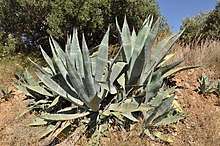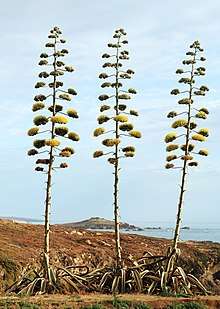Agave americana
Agave americana, common names sentry plant, century plant,[4] maguey or American aloe,[5] is a species of flowering plant in the family Asparagaceae, native to Mexico and the United States in New Mexico, Arizona and Texas. Today, it is cultivated worldwide as an ornamental plant. It has become naturalized in many regions, including the West Indies, parts of South America, the southern Mediterranean Basin, and parts of Africa, India, China, Thailand, and Australia.[6]
| Agave americana | |
|---|---|
 | |
| Scientific classification | |
| Kingdom: | Plantae |
| Clade: | Tracheophytes |
| Clade: | Angiosperms |
| Clade: | Monocots |
| Order: | Asparagales |
| Family: | Asparagaceae |
| Subfamily: | Agavoideae |
| Genus: | Agave |
| Species: | A. americana |
| Binomial name | |
| Agave americana | |
| Synonyms[2][3] | |
|
Synonyms list
| |

Despite the common name "American aloe", it is not closely related to plants in the genus Aloe.
Description
.jpg)
Although it is called the century plant, it typically lives only 10 to 30 years. It has a spread around 6–10 ft (1.8–3.0 m) with gray-green leaves of 3–5 ft (0.9–1.5 m) long, each with a prickly margin and a heavy spike at the tip that can pierce deeply. Near the end of its life, the plant sends up a tall, branched stalk, laden with yellow blossoms, that may reach a total height up to 25–30 ft (8–9 m) tall.
Its common name derives from its semelparous nature of flowering only once at the end of its long life. The plant dies after flowering, but produces suckers or adventitious shoots from the base, which continue its growth.[7]
Taxonomy and naming
A. americana was one of the many species described by Carl Linnaeus in the 1753 edition of Species Plantarum, with the binomial name that is still used today.[1]
Cultivation
A. americana is cultivated as an ornamental plant for the large dramatic form of mature plants—for modernist, drought tolerant, and desert-style cactus gardens—among many planted settings. It is often used in hot climates and where drought conditions occur.[8] The plants can be evocative of 18th-19th-century Spanish colonial and Mexican provincial areas in the Southwestern United States, California, and xeric Mexico. It is also a popular landscape plant in dry beach gardens in Florida and coastal areas of the Southeastern United States.
Subspecies and varieties
Two subspecies and two varieties of Agave americana are recognized by the World Checklist of Selected Plant Families:[9]
- A. americana subsp. americana
- A. americana subsp. protamericana Gentry
- A. americana var. expansa (Jacobi) Gentry
- A. americana var. oaxacensis Gentry
- A. americana var. marginata Trel. in L.H.Bailey, Stand. Cycl. Hort. 1: 235 (1914).
- A. americana var. picta (Salm-Dyck) A.Terracc., Prim. Contr. Monogr. Agave (1885).
- 'Marginata' agm[12] with yellow stripes along the margins of each leaf
- 'Mediopicta' agm[13] with a broad cream central stripe
- 'Mediopicta Alba' agm[14] with a central white band
- 'Mediopicta Aurea' with a central yellow band
- 'Striata' with multiple yellow to white stripes along the leaves
- 'Variegata' agm[15] with white edges on the leaves.
(those marked agm, as well as the parent species,[16] have gained the Royal Horticultural Society's Award of Garden Merit).
Uses
Culinary
If the flower stem is cut before flowering, a sweet liquid called aguamiel ("honey water") gathers in the hollowed heart of the plant. This can be fermented to produce the alcoholic drink called pulque. The leaves also yield fibers, known as pita, which are suitable for making rope, matting, or coarse cloth. They are also used for embroidery of leather in a technique known as piteado. Both pulque and maguey fiber were important to the economy of pre-Columbian Mexico, where the fermented drink was known as octli.[17]
In the tequila-producing regions of Mexico, agaves are called mezcales. The high-alcohol product of fermented agave distillation is called mezcal; A. americana is one of several agaves used for distillation. A mezcal called tequila is produced from Agave tequilana, commonly called "blue agave". The many different types of mezcal include some which may be flavored with the very pungent mezcal worm.[18] Mezcal and tequila, although also produced from agave plants, are different from pulque in their technique for extracting the sugars from the heart of the plant, and in that they are distilled spirits. In mezcal and tequila production, the sugars are extracted from the piñas (or hearts) by heating them in ovens, rather than by collecting aguamiel from the plant's cut stalk. Thus, if one were to distill pulque, it would not be a form of mezcal, but rather a different drink.[19]
Agave nectar is marketed as a natural form of sugar with a low glycemic index that is due to its high fructose content.[20]
Heraldry
The plant figures in the coat of arms of Don Diego de Mendoza, a Native American governor of the village of Ajacuba, Hidalgo.[21]
See also
References
- "Agave americana". Germplasm Resources Information Network (GRIN). Agricultural Research Service (ARS), United States Department of Agriculture (USDA). Retrieved 2010-01-12.
- "Tropicos - Name - Agave americana L." www.tropicos.org. Retrieved 4 July 2017.
- "Agave americana L. — The Plant List". www.theplantlist.org. Retrieved 4 July 2017.
- "BSBI List 2007". Botanical Society of Britain and Ireland. Archived from the original (xls) on 2014-10-23. Retrieved 2014-10-17.
- Bailey, L.H.; Bailey, E.Z.; the staff of the Liberty Hyde Bailey Hortorium. 1976. Hortus third: A concise dictionary of plants cultivated in the United States and Canada. Macmillan, New York.
- Irish, Gary (2000). Agaves, Yuccas, and Related Plants: A Gardener's Guide. Timber Press. pp. 94–97. ISBN 978-0-88192-442-8.
- RHS A-Z encyclopedia of garden plants. United Kingdom: Dorling Kindersley. 2008. p. 1136. ISBN 978-1405332965.
- "Agave americana (American century plant)". Native Plant Database. Retrieved 2013-06-11.
- Search for "Agave americana", "World Checklist of Selected Plant Families". Royal Botanic Gardens, Kew. Retrieved 2012-12-12.
- Vermeulen, Nico. 1998. The Complete Encyclopedia of Container Plants, pp. 36-37. Netherlands: Rebo International. ISBN 90-366-1584-4
- Royal Horticultural Society Database : Agave americana Archived December 1, 2011, at the Wayback Machine, retrieved 2011-07-28
- "RHS Plant Selector - Agave americana 'Marginata'". Retrieved 2015-06-17.
- "RHS Plant Selector - Agave americana 'Mediopicta'". Retrieved 23 February 2020.
- "RHS Plant Selector - Agave americana 'Mediopicta Alba'". Retrieved 23 February 2020.
- "RHS Plant Selector - Agave americana 'Variegata'". Retrieved 23 February 2020.
- "RHS Plant Selector - Agave americana". Retrieved 23 February 2020.
- Dr. Aguilar, Moreno (2006). Handbook to Life in the Aztec World. Los Angeles: California State University. pp. 371. ISBN 0-8160-5673-0.
- Hansen, Barbara (June 21, 2011). "Escamoles & Maguey Worms: John Sedlar on the Joy of Eating Bugs". L.A. Weekly.
- Barbezat, Suzanne (2017-08-28). "Tequila, Mezcal and Pulque". TripSavvy. Retrieved 2018-07-25.
- Oudhia, P. (2007). "Agave americana L." Plant Resources of Tropical Africa.
- pacbell.net/nelsnfam/mexico Archived July 6, 2008, at the Wayback Machine
Further reading
- Brandes, Stanley. "Maguey". Encyclopedia of Mexico. Chicago: Fitzroy Dearborn 1997, pp. 767–769.
- Gonçalves de Lima, Oswaldo. El maguey y el pulque en los códices mexicanos. Mexico City: Fondo de Cultura Económica 1956.
- Payno, Manuel. Memoria sobre el maguey mexicano y sus diversos productos. Mexico City: Boix 1864.
External links
| Wikimedia Commons has media related to Agave americana. |
- USDA Plants Profile for Agave americana (American century plant)
- Lady Bird Johnson Wildflower Center Native Plant Information Network (NPIN) — Agave americana
- Agave americana — UC Photos gallery
- Espelie, Karl E.; Wattendorff, Joachim; Kolattukudy, P. E. (1982). "Composition and ultrastructure of the suberized cell wall of isolated crystal idioblasts from Agave americana L. leaves". Planta. 155 (2): 166–75. doi:10.1007/BF00392548. PMID 24271671.